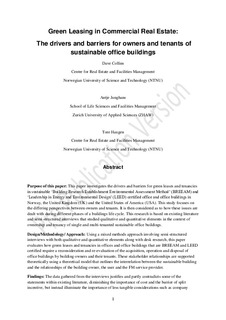| dc.contributor.author | Collins, David | |
| dc.contributor.author | Haugen, Tore | |
| dc.contributor.author | Junghans, Antje | |
| dc.date.accessioned | 2019-02-21T12:52:30Z | |
| dc.date.available | 2019-02-21T12:52:30Z | |
| dc.date.created | 2018-11-09T14:57:53Z | |
| dc.date.issued | 2018 | |
| dc.identifier.citation | Journal of Corporate Real Estate. 2018, 20 (4), 244-259. | nb_NO |
| dc.identifier.issn | 1463-001X | |
| dc.identifier.uri | http://hdl.handle.net/11250/2586786 | |
| dc.description.abstract | Abstract Purpose – This paper aims to investigate the drivers and barriers for green leases and tenancies in sustainable “Building Research Establishment Environmental Assessment Method” (BREEAM) and “Leadership in Energy and Environmental Design” (LEED) certified office and office buildings in Norway, the UK and the USA. This study focuses on the differing perspectives between owners and tenants. It is then considered as to how these issues are dealt with during different phases of a buildings life cycle. This research is based on existing literature and semi-structured interviews that studied qualitative and quantitative elements in the context of ownership and tenancy of single and multi-tenanted sustainable office buildings. Design/methodology/approach – Using a mixed-method approach involving semi-structured interviews with both qualitative and quantitative elements along with desk research, this paper evaluates how green leases and tenancies in offices and office buildings that are BREEAM and LEED certified require a reconsideration and reevaluation of the acquisition, operation and disposal of office buildings by building owners and their tenants. These stakeholder relationships are supported theoretically using a theoretical model that outlines the interrelation between the sustainable building and the relationships of the building owner, the user and the FM service provider. Findings – The data gathered from the interviews justify and partly contradict some of the statements within existing literature, diminishing the importance of cost and the barrier of split incentive but instead illuminate the importance of less tangible considerations such as company policy or a sustainability strategy. The results also note the realisation of a changing market for commercial real estate driven by the sustainable business needs of tenants for the occupation of workspaces. Research limitations/implications – These findings have the potential to further develop theories and provide an insight into how the relationships between actors from a business, procurement and contractual perspective need to be developed to ensure more proactive development of green leasing of new and existing sustainable office buildings, along with where strategic attention is required during the building design, construction, operational and use phases. Originality/value – This paper is based on original research through interviews and literature studies supported by an existing theoretical model. The results have been partly presented and initially discussed at the WBC World Congress 2016 in Tampere, Finland. Keywords Commercial office users, Green leasing, Sustainability strategy, Sustainable buildings, Sustainable facilities and services, Commercial real estate (CRE) Paper type Research paper | nb_NO |
| dc.language.iso | eng | nb_NO |
| dc.publisher | Emerald | nb_NO |
| dc.title | Green leasing in commercial real estate The drivers and barriers for owners and tenants of sustainable office buildings | nb_NO |
| dc.title.alternative | Green leasing in commercial real estate The drivers and barriers for owners and tenants of sustainable office buildings | nb_NO |
| dc.type | Journal article | nb_NO |
| dc.type | Peer reviewed | nb_NO |
| dc.description.version | acceptedVersion | nb_NO |
| dc.source.pagenumber | 244-259 | nb_NO |
| dc.source.volume | 20 | nb_NO |
| dc.source.journal | Journal of Corporate Real Estate | nb_NO |
| dc.source.issue | 4 | nb_NO |
| dc.identifier.doi | 10.1108/jcre-01-2017-0003 | |
| dc.identifier.cristin | 1628774 | |
| dc.description.localcode | © 2018. This is the authors' accepted and refereed manuscript to the article. The final authenticated version is available online at: https://doi.org/10.1108/JCRE-01-2017-0003 | nb_NO |
| cristin.unitcode | 194,61,50,0 | |
| cristin.unitname | Institutt for arkitektur og planlegging | |
| cristin.ispublished | true | |
| cristin.fulltext | preprint | |
| cristin.qualitycode | 1 | |
